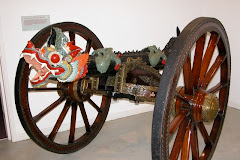This article will briefly set out the roles in the period of smoothbore artillery - i.e. before the middle of the 19th Century, when there was a major upheaval in the development of artillery. (Smoothbore versus rifled artillery and the meaning of those two terms will appear in another article in due course.)
Cannons and mortars were the earliest of the artillery weapons. The essential difference between the two lay in their trajectories. The cannon fired a solid cannonball with a large charge of gunpowder to propel it out of the barrel at a high speed: the cannonball gradually slowed down as it travelled along its very 'flat' trajectory. This slowing down produces the curved shape of a trajectory as gravity gradually takes a greater effect and pulls the projectile downwards.
The cannon's role on the battlefield was like that of the bowler in a bowling alley, knocking down skittles, only these were soldiers or horses. In siege warfare, the cannon's task was to breach the walls of a fortress so that the infantry could get inside. These walls tended to be thick and high, and needed heavy shot fired at a high velocity. Clearly, then, a cannon was a 'direct fire' weapon - it engaged targets it could 'see', just like a tank gun does today.

The mortar, on the other hand, was almost exactly the opposite. It lobbed shells in a trajectory that was like that of a tennis player's lob over his opponent's head - going steeply up and descending equally steeply. A mortar's maximum range (distance fired) tended to be much less than that of a cannon, but it could project its shells over intervening obstacles like fortress walls, small hills or woods. Mortar ammunition consequently developed along different lines. A mortar could deliver heavier projectiles and in the early days, they often fired a charge of large stones, showering these down on the those inside the fortress. Another much-used projectile was an incendiary that would cause fires in the timber constructions inside the fortress. Later it became easier to cast hollow shells and these usually had a filling of gunpowder to provide an explosion at the target end.
Inevitably, someone had the idea that it would be useful to combine the roles of a mortar and a cannon in a single weapon that could both lob exploding shells and project them to greater ranges. This new weapon was called a 'howitzer' and, of course, was a compromise: it was not possible to achieve either the greater weight of shot of the mortar or the range and hitting power of the cannon. However, it could do a bit of both roles and was regarded as a useful weapon. In the Royal Artillery at the time of the Napoleonic Wars, howitzers were often incorporated in a battery of cannons so that both capabilities were available on the manoeuvre battlefield.




Hi Harveian,
ReplyDeleteGood piece. I got a quick question. Is it possible to tell from the sound produced say 2kms from the origin what kind of weapon was fired? Grazie
If you are asking this in the context of the above piece, I think the most you could have said at that time was that the sound was that of a mortar, a field gun or a heavy weapon like a siege gun - each has a different type of sound, though you would almost certainly not be able to say which calibre of weapon.
ReplyDeleteAs for modern weapons, the same applies, and you are not likely to do better than that with the human ear! On the other hand, a sophisticated electronic sound-ranging system can often do more than simply locate a weapon by analysing the sound wave received. However, there are all sorts of factors that can make that analysis difficult, including weather conditions and what other sounds are occurring at the same time, as is frequently the case on a battlefield.
Thanks. Yes I was asking in regard to the above because I gather shells fired from a mortar explode upon impact and thus one wouln't tell that they were fired till they hit the target. The contrary is true I guess for shells fired from a cannon where the sound is immediate and louder?
ReplyDeleteAssuming you are still talking about the days of smoothbore guns (ie before the middle of the 19th Century), both cannons and mortars could fire exploding ammunition (though it was more usually the province of a howitzer than a cannon).
ReplyDeleteSince the damage was to be done by the fragmenting shell, a lower propelling charge was used than for a solid cannonball, where kinetic energy was required. In turn, this tended to make the sound of a mortar or howitzer less of a 'crack' than that achieved by the higher muzzle velocity of a cannon.
In practice, these comments still apply for today's weapons. You can still hear mortars firing at a range of 2 kms - the sound is definitely more of a 'pop' than a 'crack', but it is quite distinctive and you would not have to wait for the shell to explode before realising that mortars were being fired.